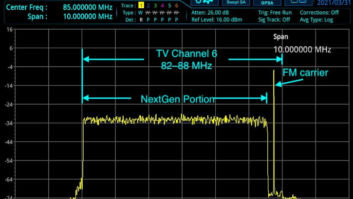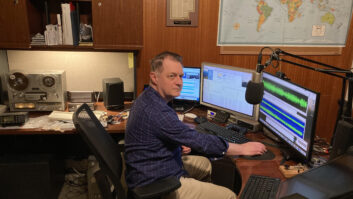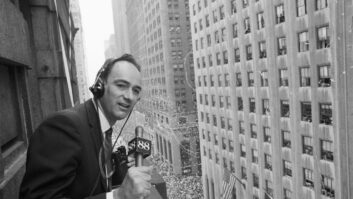WASHINGTON In the rush to digital, one of the tuner positions that’s being vacated in droves is Channel 6 (82 to 88 MHz). But for their audiences that have, in the past, accessed the channel over FM, some broadcasters are taking steps to remain on the radio dial after the transition.
FCC records indicate only a handful of post-transition ch. 6 broadcasters have decided to remain in their old neighborhoods. Prevailing opinion has it that ch. 6 (and low-band VHF frequencies in general) isn’t really a fit place for television, thanks not only to impulse noise, but also to less than due diligence by the FCC. This is one of the reasons that an old-line Oklahoma ch. 6 broadcaster cites for moving to a UHF slot.
“Tulsa is in the Bible belt—some say it’s the buckle—and the FCC’s radio division allows non-commercial FM stations to encroach on the aural subcarrier of ch. 6,” said Gerald Weaver, director of engineering at Tulsa’s KOTV. “Around here these are typically religious stations and we have one radio station sitting very close to our aural carrier. A number of our viewers are hearing them instead of our audio.”

Many consumers listen to Channel 6 broadcasts on FM, but that will change once analog is shut off. Asked about any regrets in leaving the lower six, Weaver said that it would be in shutting down his Harris Platinum VHF transmitter.
“It’s roughly 10 years old and still has a lot of life left in it,” Weaver said. “It’s always been very reliable.”
HEY, NOT SO FAST…
Other ch. 6 broadcasters, however, feel their channel assignment has a lot of life left in it and could be actually be beachfront property in the post-transition world.
“I’m a believer in low-band television,” said Fred Lass, director of engineering at WRGB, a ch. 6 station licensed to Schenectady, N.Y. “We’re in an area where there are a lot of mountains and the predictions indicate that we’ll get better coverage as a V. Low-band signals tend to bend over the horizon.”
Billy Ward, chief engineer at KTVM in Butte, Mont. also feels ch. 6 is a good place to be. KTVM is another of the full-power stations that will keep its ch. 6 allocation.
“The FCC originally offered us ch. 2, but we didn’t really want that,” Ward said. “Then they gave us channel 34 and we thought that terrain issues would be a factor—there are a lot of mountains here in Montana. Channel branding had a lot to do with it too. Overall, ch. 6 looks like the best choice.”
ELECTRIC BILL
Coverage in mountainous terrain aside, one very apparent benefit to staying VHF is reduced operating costs. Lass says that WRGB’s new ch. 6 digital transmitter should be completely paid for in a few years from electrical power saved by not going UHF.
Philadelphia is another DMA where ch. 6 will hang around after the transition. Hank Volpe, vice president and director of engineering at WPVI-TV there said that his new Harris 8 kW digital transmitter isn’t “breaking a sweat” in providing full DTV service.
“Our original allocation was for 3.81 kW ERP,” Volpe said. “We went up as far as we could without causing interference problems—to 7.56 kW ERP. Right now I’m putting a shade under 4 kW from the transmitter into a standby antenna. When we make the switch to the main antenna I’ll only need 1.7 kW. I’m not operating a transmitter; I’m running a hair dryer.”
Ch. 6 interference issues don’t seem particularly worrisome to Volpe, noting that initial testing at “realistic power levels” indicates that future DTV operations will go smoothly.
“We were a little worried about some of the ridges north and west of here, and manmade interference, but we’ve done some testing at night and have been pretty successful,” he said. “The reception in the counties we serve has been good.”
Ch. 6 broadcasters are aware that they have a “shadow” audience, as their 87.8 MHz audio carrier can be heard on FM receivers. While it’s doubtful that Arbitron ever tried to chart this audience, it’s thought to be large.
WRGB’s Lass estimates that the number of Albany/Schenectady ch. 6 radio listeners is probably equal to the station’s off-air viewership.
Hank Volpe agrees that 87.7 is a popular FM dial setting around Philadelphia too.
“I really don’t know what the number of listeners is,” he said, “But it is significant. After ‘why do I need a converter?’ that’s the second most asked question at our DTV help desk. People seem really upset to learn that 87.7 is going away. I admit that I’m going to miss listening to Jeopardy while I’m driving.”
It’s not all about entertainment either. That was proven a few weeks ago in the aftermath of an ice storm that struck Western Kentucky.
Joey Gill, chief engineer at WSPD-TV in Paducah, said that with the majority of area radio stations down for the count, his ch. 6 station’s audio was the primary source of news and information on the FM dial. “It’s really a shame that this goes away when we transition to our UHF channel,” Gill said. “We just wish we had some way to keep an FM audio carrier up.”
HYBRID OPERATION?

WPVI-TV’s ch. 6 analog vs. digital signal coverage. Courtesy Hammett & Edison WRGB’s Lass may have found a solution.
“We have a plan to continue operating on 87.7 after we go digital,” he said. “We think that it’s possible to operate with a vertically polarized analog FM audio carrier when we go back to ch. 6 for DTV. That signal will be horizontally polarized, of course, and there should be enough cross pol isolation to make it work.”
Lass admits that he really hasn’t tried this yet, but thinks it should work. In theory it’s similar to wrapping an IBOC digital radio signal around an analog FM carrier. This is shown to work, and those signals don’t have the 20 dB or so isolation advantage that antenna cross polarization offers. The overall emission bandwidth would not exceed a licensee’s 6 MHz channel and DTV demods would ignore the analog carrier. About the only downside would be an increased “noise floor” under the FM carrier. This might reduce the FM signal availability at the edges of a station’s coverage area. “We’re really interested in proving this concept and are thinking of applying for an experimental license,” Lass said.
There would be an additional operational benefit too if the remaining ch. 6 stations could keep program audio on 87.7. This would provide latency-free IFB communications for talent in the field without having to set up additional communications paths. The only downside to post-transition ch. 6 hybrid broadcasting would appear to come from the intellectual property side of the business.
WPVI’s Volpe said he’d looked into keeping an FM carrier up too, but thinks there might be contractual issues resulting from limitations placed on programming use. This surfaced when some radio and television stations began streaming program audio.
“The copyright laws could be a problem,” Volpe said. “We’re struggling to find out what can be done. The technology would allow me to keep the audio up, but would we be breaking some copyright laws if we did? When you look at the whole issue of TV and Internet media, this is one of the big issues that has to be resolved. I don’t know how easy it would be to overcome the copyright situation. I’m not a lawyer. However all of us enjoy the fact that when we’re driving we can hear the audio portion of things.”












